Developing an Improved Parameter Estimation Method for the Segmented Taper Equation through Combination of Constrained Two-Dimensional Optimum Seeking and Least Square Regression
Abstract
:1. Introduction
2. Materials and Methods
2.1. Data
2.2. Taper Equation
2.3. CTOS & LSR Method
- Step 1:
- The feasible region of variable 1 was () and the feasible region of variable 2 was (). The four corners of a rectangle formed by the overlapped area were represented by , , , and , respectively. In rectangle , four interior points , , , and were obtained from the intersections of the following four lines:
- Step 2:
- θ in Equation (1) was estimated at each interior point with known coordinates by LSR, the objective functions , , and were computed, and the interior point that had the minimum objective function value was denoted as temp point.
- Step 3:
- If was the minimum, then the rectangle with as the secondary diagonal was reserved; if was the minimum, the rectangle with as the secondary diagonal was reserved; if was the minimum, the rectangle with as the secondary diagonal was reserved; if was the minimum, the rectangle with as the secondary diagonal was reserved. The four corners of the new rectangle were denoted as , , , and , respectively. , the four interior points, , , and in the new rectangle also were determined by the golden section method. Computed distance would be .
- Step 4:
- Steps 2 and 3 were repeated until a desired precision was obtained, for example, . The final and were obtained, and then were estimated by LSR.
2.4. ULSR Method
2.5. Taper Equation Evaluation
3. Results
3.1. Taper Equation at Individual Tree-Level
3.2. Taper Equation at Population Average-Level
4. Discussion
5. Conclusions
Acknowledgments
Author Contributions
Conflicts of Interest
Appendix
Function Do_Function_Two_dimensional_optimization_selection(Independ_Col() As Long, dePendent_Col() As Long, Independ_Name() As String, dePendent_Name() As String, a_ValueRegion() As Double, b_ValueRegion() As Double, startPoint As Long, EndPoint As Long) Dim Independ_value() As Double, dePendent_value() As Double, n As Long, i As Long, j As Long, xyData() As Double, Para_value() As Double, Mat_result() As Variant n = EndPoint − startPoint + 1 ReDim Independ_value(n, UBound(Independ_Col)) ReDim dePendent_value(n, UBound(dePendent_Col)) For i = 1 To n For j = 1 To UBound(Independ_Col) Independ_value(i, j) = frmData.DataTab1.TextMatrix(i + startPoint − 1, Independ_Col(j)) Next j For j = 1 To UBound(dePendent_Col) If frmData.DataTab1.TextMatrix(i + startPoint − 1, dePendent_Col(j)) = "" Then frmData.DataTab1.TextMatrix(i + startPoint − 1, dePendent_Col(j)) = "00" End If dePendent_value(i, j) = frmData.DataTab1.TextMatrix(i + startPoint − 1, dePendent_Col(j)) Next j Next i ReDim xyData(1 To n, UBound(Independ_Col) + UBound(dePendent_Col)) For i = 1 To n For j = 1 To UBound(Independ_Col) xyData(i, j) = Independ_value(i, j) Next j Next i For i = 1 To n For j = 1 To UBound(dePendent_Col) xyData(i, j + UBound(Independ_Col)) = dePendent_value(i, j) Next j Next i ReturnVal = two_dimensional_optimization_selection_Tang(xyData(), a_ValueRegion(), b_ValueRegion(), Para_value()) ReDim Mat_result(1, 7) Mat_result(0, 1) = "a1" : Mat_result(0, 2) = "a2" : Mat_result(0, 3) = "b1" Mat_result(0, 4) = "b2" : Mat_result(0, 5) = "b3" : Mat_result(0, 6) = "b4" Mat_result(0, 7) = "E2" : Mat_result(1, 1) = ReturnVal(1) : Mat_result(1, 2) = ReturnVal(2) Mat_result(1, 3) = Para_value(1) : Mat_result(1, 4) = Para_value(2) Mat_result(1, 5) = Para_value(3) : Mat_result(1, 6) = Para_value(4) Mat_result(1, 7) = ReturnVal(0) With frmOutput.Text1 Call TextPrint(Mat_result, PrintFormat0, , , 0) End With Call Do_WriteOutputTxt Exit Function
Function two_dimensional_optimization_selection_Tang(xyData() As Double, a_ValueRegion() As Double, b_ValueRegion() As Double, Para_value() As Double) Dim i As Integer, j As Integer, Sa1 As Double, Sb1 As Double, Sa2 As Double, Sb2 As Double, x1 As Double, x2 As Double, Y1 As Double, y2 As Double, Nx1 As Double, Nx2 As Double, Ny1 As Double, Ny2 As Double, r1 As Double, r2 As Double, R3 As Double, R4 As Double, temp As Double, dis As Double, Best1 As Double, Best2 As Double, ER As Double, reVal() As Double Sx1 = a_ValueRegion(1) Sx2 = a_ValueRegion(2) 'the feasible range for the first variable Sy1 = b_ValueRegion(1) Sy2 = b_ValueRegion(2) 'the feasible range for the second variable x1 = Sx1 x2 = Sx2 Y1 = Sy1 y2 = Sy2 dis = ((x1 − x2)^2 + (Y1 − y2)^2)^0.5 While (dis >0.0000000001) Nx1 = x1 + (x2 − x1) × 0.382 Nx2 = x1 + (x2 − x1) × 0.618 Ny1 = Y1 + (y2 − Y1) × 0.382 Ny2 = Y1 + (y2 − Y1) × 0.618 r1 = ErrorC(Nx1, Ny2, xyData, Para_value) r2 = ErrorC(Nx2, Ny2, xyData, Para_value) R3 = ErrorC(Nx1, Ny1, xyData, Para_value) R4 = ErrorC(Nx2, Ny1, xyData, Para_value) If (r1 <r2) Then temp = r1 Else temp = r2 End If If (R3 <temp) Then temp = R3 End If If (R4 <temp) Then temp = R4 End If If (temp = r1) Then Y1 = Ny1 x2 = Nx2 Best1 = Nx1 Best2 = Ny2 ElseIf (temp = r2) Then x1 = Nx1 Y1 = Ny1 Best1 = Nx2 Best2 = Ny2 ElseIf (temp = R3) Then x2 = Nx2 y2 = Ny2 Best1 = Nx1 Best2 = Ny1 Else x1 = Nx1 y2 = Ny2 Best1 = Nx2 Best2 = Ny1 End If dis = ((x1 − x2)^2 + (Y1 − y2)^2)^0.5 ER = ErrorC(Best1, Best2, xyData, Para_value) ReDim reVal(2) reVal(0) = ER reVal(1) = Best1 reVal(2) = Best2 two_dimensional_optimization_selection_Tang = reVal Exit Function End Function
Function ErrorC(Best1 As Double, Best2 As Double, xyData() As Double, Para_value() As Double) Dim ReturnVal() As Double, i As Integer, j As Integer, iniParValues() As Double, X() As Double, Y() As Double, n As Integer, x1() As Double, x2() As Double,x3() As Double, x4() As Double, EstVal() As Variant, ResVal() As Variant, Sum_Res As Double, Rel() As Double n = UBound(xyData, 1) ReDim x1(n): ReDim x2(n): ReDim x3(n): ReDim x4(n) For i = 1 To n x1(i) = xyData(i, 1) − 1 x2(i) = xyData(i, 1)^2 − 1 If Best1 >= xyData(i, 1) Then x3(i) = (Best1 − xyData(i, 1))^2/(Best1 − x1(i)) Else x3(i) = 0 End If If Best2 >= xyData(i, 1) Then x4(i) = (Best2 − xyData(i, 1))^2 Else x4(i) = 0 End If Next i ReDim X(n, 4) For i = 1 To n X(i, 1) = x1(i) X(i, 2) = x2(i) X(i, 3) = x3(i) X(i, 4) = x4(i) Next i ReDim Y(n) For i = 1 To n Y(i) = xyData(i, 2) Next i Rel = LinReg(X, Y) ReDim Para_value(4) For i = 1 To 4 Para_value(i) = Rel(i, 1) Next i ReDim EstVal(n) ReDim ResVal(n) Sum_Res = 0 For i = 1 To n EstVal(i) = 0 For j = 1 To 4 EstVal(i) = EstVal(i) + Para_value(j) × X(i, j) Next j ResVal(i) = (Y(i) − EstVal(i))^2 Sum_Res = Sum_Res + ResVal(i) Next i ErrorC = Sum_Res Exit Function End Function
References
- Demaerschalk, J.P. Converting volume equations to compatible taper equations. For. Sci. 1972, 18, 241–245. [Google Scholar]
- Duan, A.; Zhang, S.; Zhang, X.; Zhang, J. Development of a stem taper equation and modelling the effect of stand density on taper for Chinese fir plantations in Southern China. PeerJ 2016, 4, e1929. [Google Scholar] [CrossRef] [PubMed]
- Kozak, A. A variable-exponent taper equation. Can. J. For. Res. 1988, 18, 1363–1368. [Google Scholar] [CrossRef]
- Fang, Z.; Borders, B.E.; Bailey, R.L. Compatible volume taper models for loblolly and slash pine based on system with segmented-stem form factors. For. Sci. 2000, 46, 1–12. [Google Scholar]
- Jordan, L.; Berenhaut, K.; Souter, R.; Daniels, R.F. Parsimonious and completely compatible taper, total and merchantable volume models. For. Sci. 2005, 51, 578–584. [Google Scholar]
- Kozak, A.; Munro, D.O.; Smith, J.H.G. Taper functions and their application in forest inventory. For. Chron. 1969, 45, 278–283. [Google Scholar] [CrossRef]
- Ormerod, D.W. A simple bole model. For. Chron. 1973, 49, 136–138. [Google Scholar] [CrossRef]
- Amidon, E.L. A general taper functional form to predict bole volume for five mixed-conifer species in Califomia. For. Sci. 1984, 30, 166–171. [Google Scholar]
- Biging, G.S. Taper equations for second-growth mixed conifers in northern California. For. Sci. 1984, 30, 1103–1117. [Google Scholar]
- Thomas, C.E.; Parresol, B. Simple, flexible, trigonometric taper equations. Can. J. For. Res. 1991, 21, 1132–1137. [Google Scholar] [CrossRef]
- Sharma, M.; Oderwald, R.G. Dimensionally compatible volume and taper equations. Can. J. For. Res. 2001, 31, 797–803. [Google Scholar] [CrossRef]
- Zakrzewski, W.T.; MacFarlane, D.W. Regional stem profile model for cross-border comparisons of harvested red pine (Pinus resinosa Ait.) in Ontario and Michigan. For. Sci. 2006, 52, 468–475. [Google Scholar]
- Max, T.A.; Burkhart, H.E. Segmented polynomial regression applied to taper equations. For. Sci. 1976, 22, 283–289. [Google Scholar]
- Cao, Q.V.; Burkhart, H.E.; Max, T.A. Evaluations of two methods for cubic volume prediction of loblolly pine to any merchantable limit. For. Sci. 1980, 26, 71–80. [Google Scholar]
- Valenti, M.; Cao, Q. Use of crown ratio to improve loblolly pine taper equations. Can. J. For. Res. 1986, 16, 1141–1145. [Google Scholar] [CrossRef]
- Parresol, B.; Hotvedt, J.; Cao, Q. A volume and taper prediction system for bald cypress. Can. J. For. Res. 1987, 17, 250–259. [Google Scholar] [CrossRef]
- Jiang, L.; Liu, R. Segmented taper equations with crown ratio and stand density for Dahurian Larch (Larix gmelinii) in Northeastern China. J. For. Res. 2011, 22, 347–352. [Google Scholar] [CrossRef]
- Newnham, R.M. Variable-form taper equation for four Alberta tree species. Can. J. For. Res. 1992, 22, 210–223. [Google Scholar] [CrossRef]
- Muhairwe, C.K. Tree form and taper variation over time for interior lodgepole pine. Can. J. For. Res. 1994, 24, 1904–1913. [Google Scholar] [CrossRef]
- Valentine, H.T.; Gregoire, T.G. A switching model of bole taper. Can. J. For. Res. 2001, 31, 1400–1409. [Google Scholar] [CrossRef]
- Lee, W.K.; Seo, J.H.; Son, Y.M.; Lee, K.H.; von Gadow, K. Modeling stem profiles for Pinus densiflora in Korea. For. Ecol. Manag. 2003, 172, 69–77. [Google Scholar] [CrossRef]
- Zeng, W.; Liao, Z. Research of taper equation. Sci. Silvae Sin. 1997, 33, 127–132, (In Chinese with English Summary). [Google Scholar]
- Demaerschalk, J.P.; Kozak, A. The whole-bole system: A conditioned dual equation system for precise prediction of tree profiles. Can. J. For. Res. 1997, 7, 488–497. [Google Scholar] [CrossRef]
- Cao, Q.V.; Wang, J. Calibrating fixed- and mixed-effects taper equations. For. Ecol. Manag. 2011, 262, 671–673. [Google Scholar] [CrossRef]
- Sabatia, C.O.; Burkhart, H.E. On the use of upper stem diameters to localize a segmented taper equation to new trees. For. Sci. 2015, 61, 411–423. [Google Scholar] [CrossRef]
- Rojo, A.; Perales, X.; Sanchez-Rodriguez, F.; Alvarez-Gonzalez, J.G.; von Gadow, K. Stem tape functions for maritime pine (Pinus pinaster Ait.) in Galicia (Northwestern Spain). Eur. J. For. Res. 2005, 124, 177–186. [Google Scholar] [CrossRef]
- Jiang, L.; Brooks, J.R.; Wang, J. Compatible taper and volume equations for yellow-poplar in West Virginia. For. Ecol. Manag. 2005, 213, 399–409. [Google Scholar] [CrossRef]
- Figueiredo-Filho, A.; Borders, B.E.; Hitch, K.L. Taper equations for Pinus taeda plantations in Southern Brazil. For. Ecol. Manag. 1996, 83, 39–46. [Google Scholar] [CrossRef]
- Muhairwe, C.K. Taper equations for Eucalyptus pilularis and Eucalyptus grandis for the north coast in New South Wales, Australia. For. Ecol. Manag. 1999, 113, 251–269. [Google Scholar] [CrossRef]
- Sharma, M.; Burkhart, H.E. Selecting a level of conditioning for the segmented polynomial taper equation. For. Sci. 2003, 49, 324–330. [Google Scholar]
- Coble, D.W.; Hilpp, K. Compatible cubic-foot stem volume and upper-stem diameter equations for semi-intensive plantation grown loblolly pine trees in East Texas. South J. Appl. For. 2006, 30, 132–141. [Google Scholar]
- Trincardo, G.; Burkhart, H.E. A generalized approach for modeling and localizing stem profile curves. For. Sci. 2006, 52, 670–682. [Google Scholar]
- Brooks, J.R.; Jiang, L.; Ozcelik, R. Compatible stem volume and taper equations for Brutian Pine, Taurus Cedar, and Taurus Fir in Turkey. For. Ecol. Manag. 2008, 256, 147–151. [Google Scholar] [CrossRef]
- Pang, L. Stand Harvest Analysis and Information Management System for Target Tree. Ph.D. Thesis, Chinese Academy of Forestry, Beijing, China, 2015. [Google Scholar]
- Tang, S.; Li, Y.; Wang, Y. Simultaneous equations, errors-in-variable models, and model integration in systems ecology. Ecol. Model. 2001, 142, 285–294. [Google Scholar] [CrossRef]
- Hua, L. Optimum Seeking Methods; Science Press: Beijing, China, 1967. [Google Scholar]
- Schwefel, P.H.P. Evolution and Optimum Seeking: The Sixth Generation; John Wiley & Sons, Inc.: New York, NY, USA, 1993. [Google Scholar]
- Vanclay, J.K. Modelling Forest Growth and Yield: Applications to Mixed Tropical Forests; CAB International: Wallingford, UK, 1994. [Google Scholar]
- Arlot, S.; Celisse, A. A survey of cross-validation procedures for model selection. Statist. Surv. 2010, 4, 40–79. [Google Scholar] [CrossRef]
- Yang, Y.; Huang, S. Comparison of different methods for fitting nonlinear mixed forest models and for making predictions. Can. J. For. Res. 2011, 41, 1671–1686. [Google Scholar] [CrossRef]
- Tang, S.Z.; Lang, K.J.; Li, H.K. Statistics and Computation of Biomathematical Models (ForStat Course); Science Press: Beijing, China, 2008. (In Chinese) [Google Scholar]
- Omule, A.Y. Personal bias in forest measurement. For. Chron. 1980, 56, 222–224. [Google Scholar] [CrossRef]
- Gertner, G.Z. The sensitivity of measurement error in stand volume estimation. Can. J. For. Res. 1990, 20, 800–804. [Google Scholar] [CrossRef]
- Fuller, W.A. Measurement Error Models; John Wiley and Sons: New York, NY, USA, 1987. [Google Scholar]
- Rencher, A.C.; Schaalje, G.B. Linear Models in Statistics, 2nd ed.; John Wiley and Sons: New York, NY, USA, 2008. [Google Scholar]
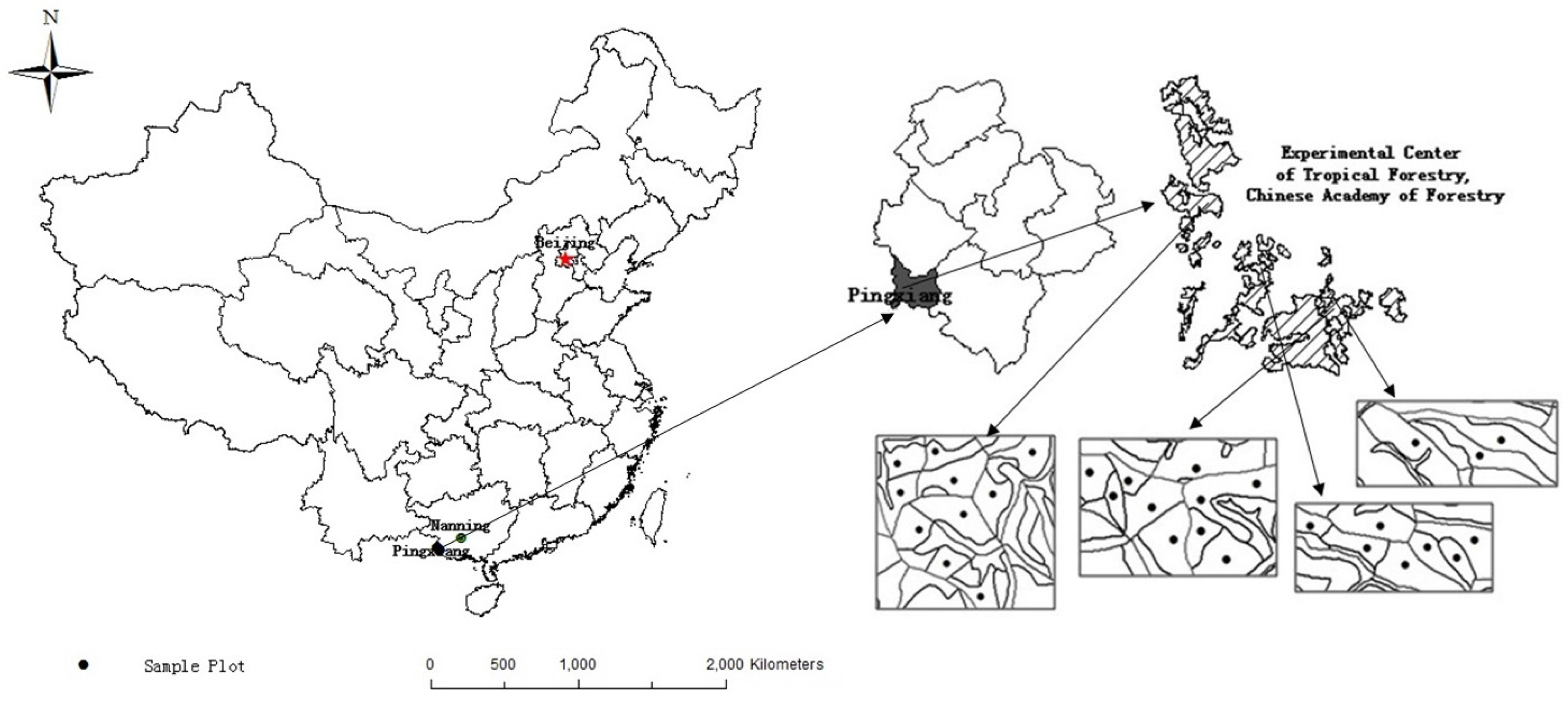
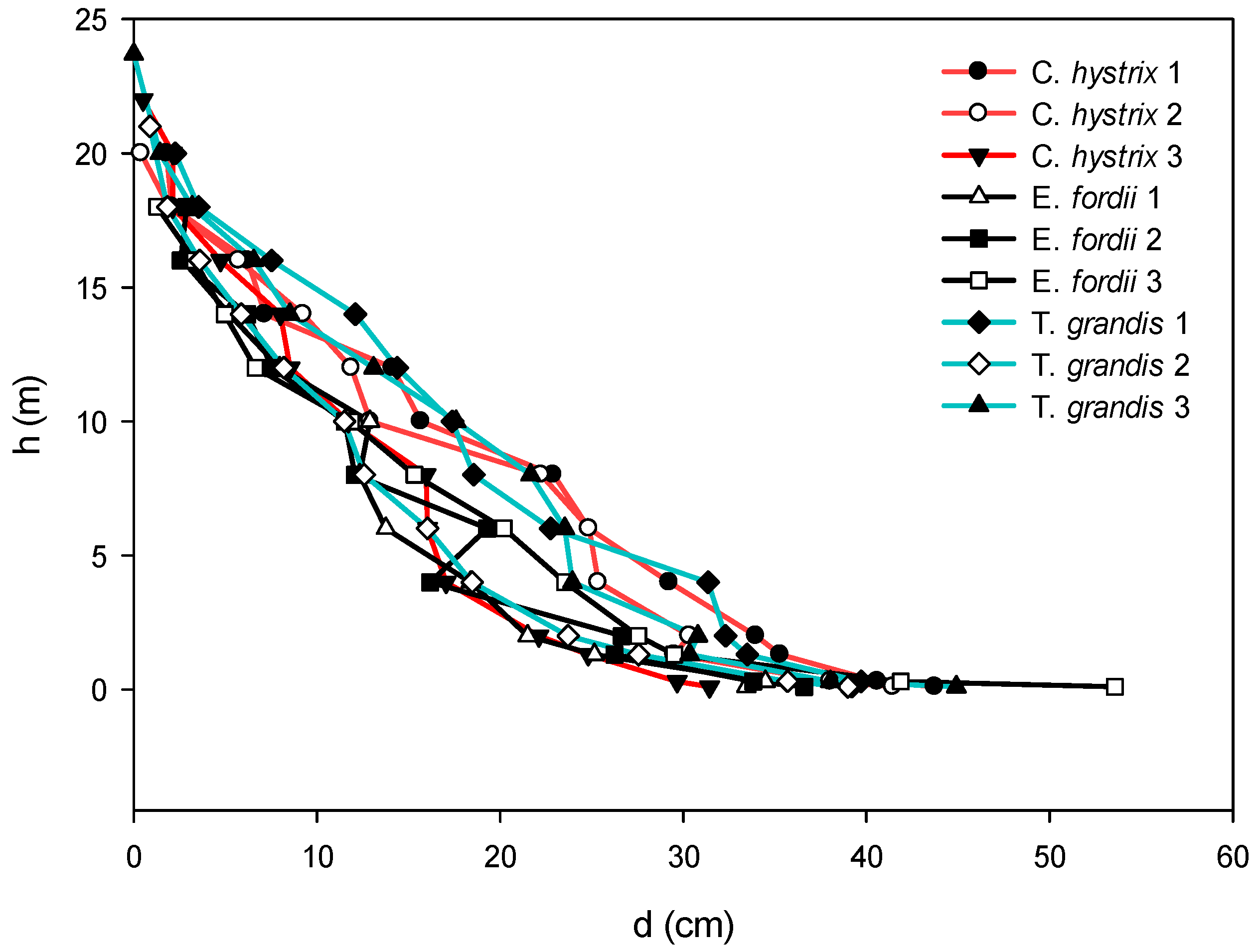
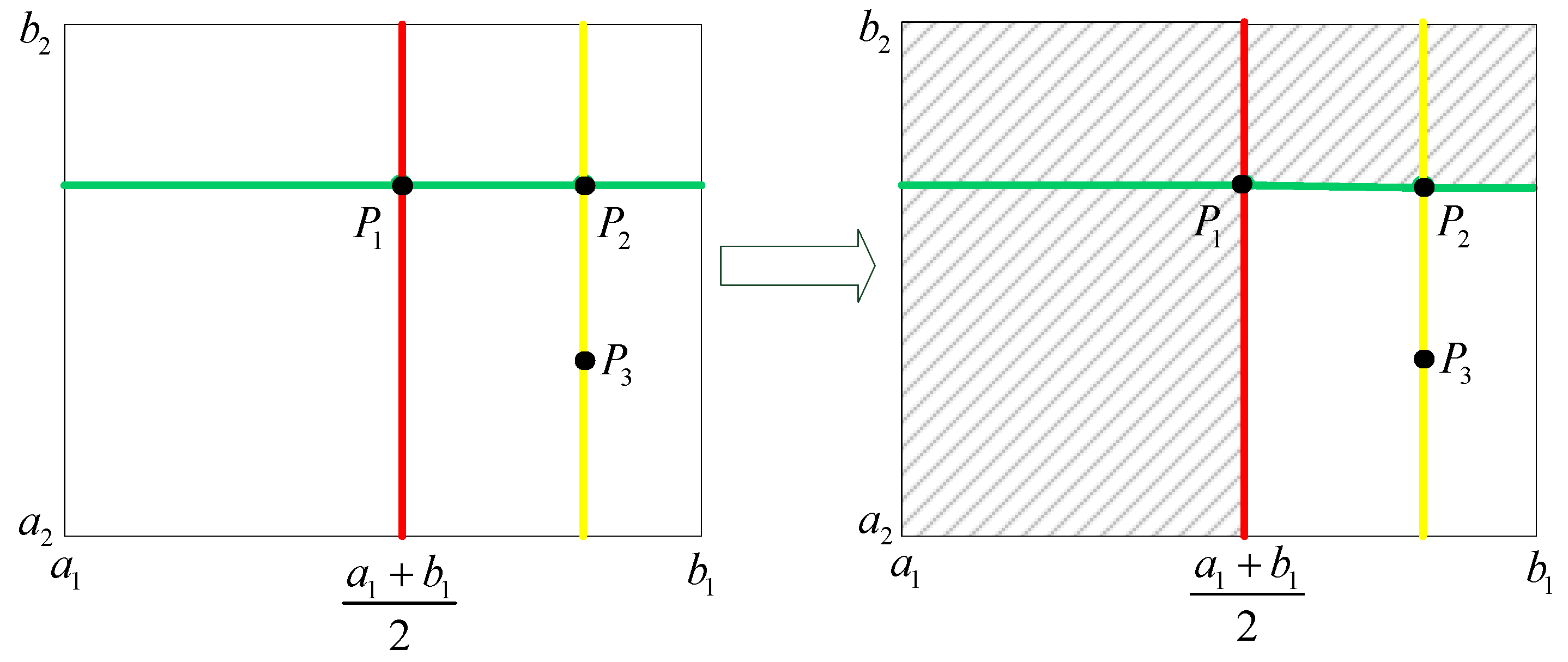
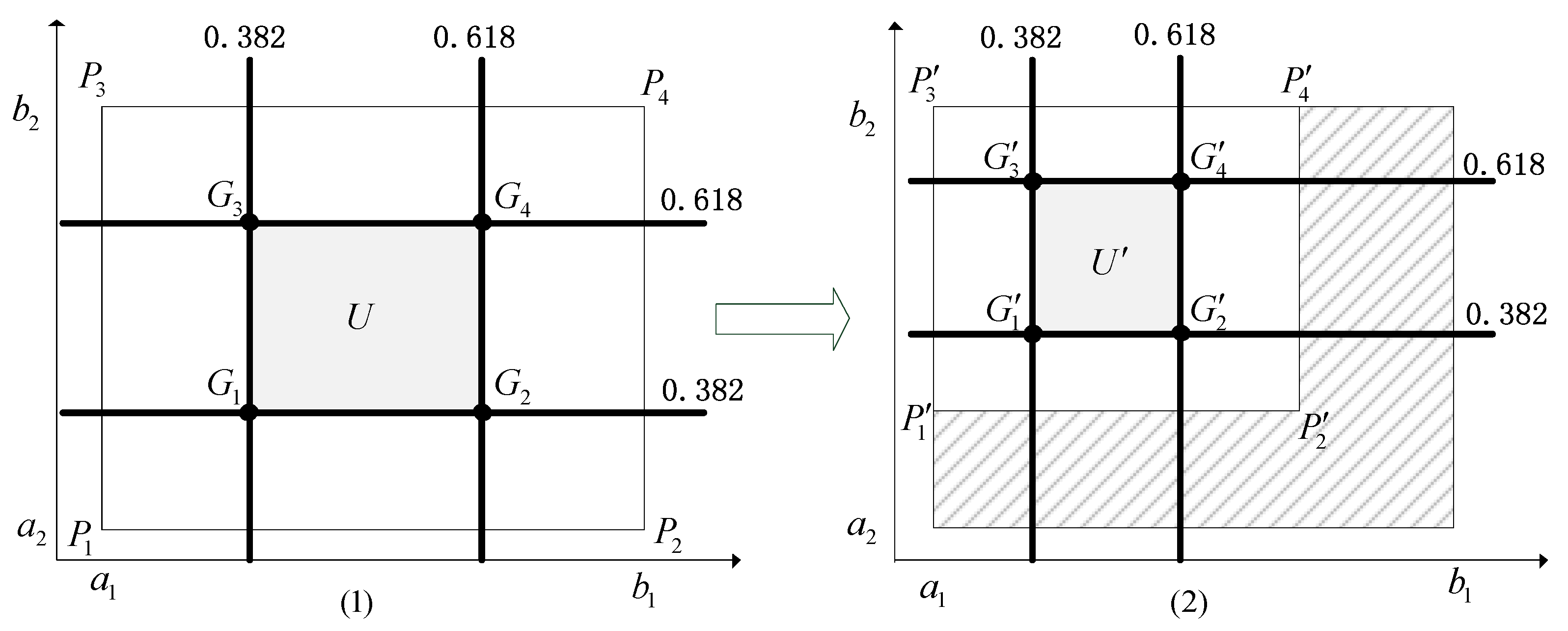


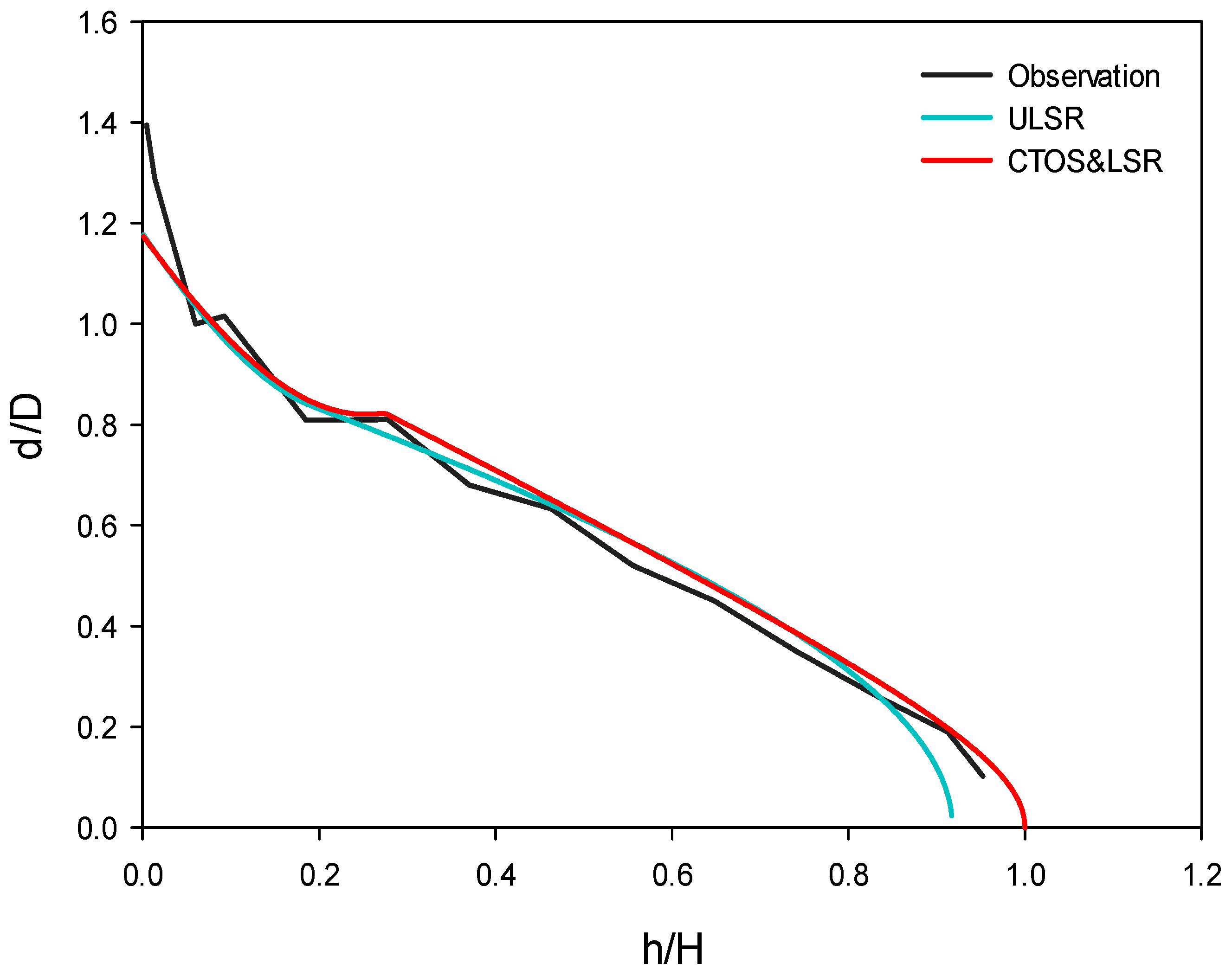

| Tree Species | Variable | No. | Mean | Max | Min | SD | CV |
|---|---|---|---|---|---|---|---|
| C. hystrix | D (cm) | 40 | 22.12 | 37.55 | 8.70 | 7.40 | 0.33 |
| H (m) | 40 | 21.43 | 30.50 | 10.10 | 5.21 | 0.24 | |
| E. fordii | D (cm) | 40 | 21.15 | 29.50 | 10.05 | 4.52 | 0.21 |
| H (m) | 40 | 18.64 | 22.40 | 11.80 | 2.71 | 0.15 | |
| T. grandi | D (cm) | 40 | 25.93 | 37.95 | 12.70 | 5.49 | 0.21 |
| H(m) | 40 | 21.16 | 27.40 | 9.30 | 3.52 | 0.17 |
| Tree Species | No. | Method | ||||||||
|---|---|---|---|---|---|---|---|---|---|---|
| C. hystrix | (1) | CTOS & LSR | 0.0579 | 0.3937 | −2.8796 | 1.3293 | 139.5926 | −3.368 | 0.0230 | 0.991 |
| ULSR | 0.0585 | 0.3937 | −2.8791 | 1.329 | −3.3658 | 129.354 | 0.0230 | 0.991 | ||
| (2) | CTOS & LSR | 0.0352 | 0.5093 | −3.2136 | 1.6851 | 182.6908 | −1.7546 | 0.0090 | 0.996 | |
| ULSR | 0.0356 | 0.5092 | −3.213 | 1.6847 | 173.213 | −1.7545 | 0.0090 | 0.996 | ||
| (3) | CTOS & LSR | 0.2292 | 0.3783 | −2.1126 | 0.8538 | 25.3279 | −7.4583 | 0.0074 | 0.997 | |
| ULSR | 0.2812 | 0.3407 | −2.1712 | 0.8912 | 32.6352 | −22.27 | 0.0066 | 0.997 | ||
| E. fordii | (1) | CTOS & LSR | 0.1595 | 0.7361 | −4.7264 | 2.3894 | 27.0427 | −2.7965 | 0.0204 | 0.989 |
| ULSR | 0.1649 | 0.7675 | −5.9143 | 3.0609 | 21.8090 | −3.4446 | 0.0206 | 0.989 | ||
| (2) | CTOS & LSR | 0.2431 | 0.2818 | −2.1716 | 0.9591 | 93.5096 | −53.8856 | 0.0299 | 0.985 | |
| ULSR | 0.0603 | 0.8665 | 2.0566 | −1.4212 | 92.6192 | 2.3332 | 0.0499 | 0.9774 | ||
| (3) | CTOS & LSR | 0.0340 | 0.3631 | −2.6455 | 1.3478 | 886.3202 | −1.7084 | 0.0029 | 0.999 | |
| ULSR | 0.0342 | 0.3695 | −2.6554 | 1.3541 | 844.7019 | −1.667 | 0.0029 | 0.999 | ||
| T. grandi | (1) | CTOS & LSR | 0.3996 | 0.5837 | −4.4012 | 2.3442 | 7.9341 | −5.2571 | 0.0179 | 0.990 |
| ULSR | 0.4916 | 0.5549 | −4.0975 | 2.1651 | 9.0758 | −9.5458 | 0.0190 | 0.990 | ||
| (2) | CTOS & LSR | 0.1385 | 0.6910 | −2.8939 | 1.4189 | 33.1479 | −1.2589 | 0.0026 | 0.999 | |
| ULSR | 0.1403 | 0.8530 | −8.4821 | 4.5000 | 27.9491 | −4.2567 | 0.0026 | 0.999 | ||
| (3) | CTOS & LSR | 0.0325 | 0.5609 | −3.4995 | 1.7276 | 558.3056 | −2.2966 | 0.0134 | 0.995 | |
| ULSR | 0.0328 | 0.5611 | −3.5011 | 1.7286 | 532.4962 | −2.2968 | 0.0134 | 0.995 |
| Tree Species | Method | ||||||
|---|---|---|---|---|---|---|---|
| C. hystrix | ULSR | 0.0481 | 0.6479 | −3.6251 | 1.7049 | 158.3459 | −2.1074 |
| CTOS & LSR | 0.0474 | 0.6479 | −3.624 | 1.7043 | 169.9877 | −2.1063 | |
| E. fordii | ULSR | 0.0444 | 0.7190 | −2.5992 | 1.1148 | 257.2861 | −0.7817 |
| CTOS & LSR | 0.0440 | 0.6910 | −2.4256 | 1.0154 | 274.0969 | −0.6923 | |
| T. grandis | ULSR | 0.0903 | 0.6993 | −2.5923 | 1.1282 | 51.1553 | −0.9210 |
| CTOS & LSR | 0.0890 | 0.6910 | −2.5193 | 1.0861 | 52.6617 | −0.8752 |
| Tree Species | Method | |||||
|---|---|---|---|---|---|---|
| C. hystrix | ULSR | 3.404 | 0.959 | −0.2518 | 2.2898 | 1.5340 |
| CTOS & LSR | 3.404 | 0.959 | −0.1814 | 2.0989 | 1.4601 | |
| E. fordii | ULSR | 4.401 | 0.953 | −0.1568 | 2.1878 | 1.4874 |
| CTOS & LSR | 4.401 | 0.953 | −0.1611 | 2.1753 | 1.4837 | |
| T. grandis | ULSR | 3.479 | 0.962 | −0.2211 | 3.7328 | 1.9446 |
| CTOS & LSR | 3.479 | 0.962 | −0.1870 | 3.5452 | 1.8921 |
© 2016 by the authors; licensee MDPI, Basel, Switzerland. This article is an open access article distributed under the terms and conditions of the Creative Commons Attribution (CC-BY) license (http://creativecommons.org/licenses/by/4.0/).
Share and Cite
Pang, L.; Ma, Y.; Sharma, R.P.; Rice, S.; Song, X.; Fu, L. Developing an Improved Parameter Estimation Method for the Segmented Taper Equation through Combination of Constrained Two-Dimensional Optimum Seeking and Least Square Regression. Forests 2016, 7, 194. https://doi.org/10.3390/f7090194
Pang L, Ma Y, Sharma RP, Rice S, Song X, Fu L. Developing an Improved Parameter Estimation Method for the Segmented Taper Equation through Combination of Constrained Two-Dimensional Optimum Seeking and Least Square Regression. Forests. 2016; 7(9):194. https://doi.org/10.3390/f7090194
Chicago/Turabian StylePang, Lifeng, Yongpeng Ma, Ram P. Sharma, Shawn Rice, Xinyu Song, and Liyong Fu. 2016. "Developing an Improved Parameter Estimation Method for the Segmented Taper Equation through Combination of Constrained Two-Dimensional Optimum Seeking and Least Square Regression" Forests 7, no. 9: 194. https://doi.org/10.3390/f7090194







